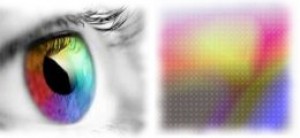Artist : Learning To ‘See’ From An Artist’s Perspective
If you were to really look at a piece of furniture, perhaps a wooden table or chair…
you would probably  notice some of the details such as the color of the wood, (most likely some ‘shade of brown’) and maybe whether it has a grain or not.
notice some of the details such as the color of the wood, (most likely some ‘shade of brown’) and maybe whether it has a grain or not.
Or…if you take a a minute to look at an article of the clothing you are wearing… (maybe a pair of jeans made of denim or a white t-shirt). You might think that the jeans were ‘just blue’; or in the case of the t-shirt, that it is ‘white’. If these things are only what you did see…there are other things about them that you probably didn’t see.
Unless you were in a dark room when you looked at the wooden furniture, there was some kind of light coming from a source such as a lamp or a nearby window. A few of the elements of the surface would appear differently than others, such as areas where the light is hitting it directly, or reflections made by objects on the surface or directly adjacent to it. You might be able to discern that these are not the same color as the wood itself… or as any of the dark color(s) that the shadows create. In fact the light that is hitting the surface, as well as; the reflections are much lighter than the surface.
Consider your jeans…
With clothing, there are numerous folds that contain areas which have light and dark properties. If you look closely at one of the folds, you’ll notice that the top of it, although still blue; it is the lightest part, and might even appear to be almost white.
I feel it is necessary at this point, to say that ‘white’ is almost never only ‘one’ specific color; and that it will actually appear very differently when various examples [of white] are viewed next to each other.
The elements…
that are white in color, which make up the wedding dress and the bouquet; in the photo to the left. Not only can you see the difference between the various shades of white contained in this dress vs. the ones in the floral bouquet she is holding, but as you can see; there are also different white shades comprising each of those elements. The dress has two distinct shades of light & dark, resulting from the way the light is ‘hitting’ & highlighting the right-side of it; & the rest is in shadow. In fact, the highlighted area on the right-side of the dress, is a color of white that contains quite a bit of warm yellow hues; which occur from having the sunlight shining directly on it… whearas; the shadows in the left-side of the dress are of shades of white that possess more cooler tones. If I was to mix this color, I would first start with white from the tube, adding very small amounts of blue, trace amount of black, & even some red to achieve the desired result. (Black of course, being the least concentrated of these).
In most cases, in order for an artist to create interesting paintings that will keep a viewer’s attention… unless they are intentionally trying to minimize colors for a specific effect or to convey a certain message or feeling, (often seen in modern art pieces); the use of color is one of the major elements an artist will employ in their painting.
Although this article is titled: “Learning to See From An Artist’s Perspective…
This article does NOT describe the techniques necessary to master issues in a painting related to the visual term ‘perspective’. Perspective in visual terms is defined as how the object or objects in a composition appear from different angles & at certain distances in relation to where the viewer is located. Instead what I have attempted to illustrate in this article regarding ‘perspective’, is related to how an artist ‘sees’ the details of objects in the world around them.


